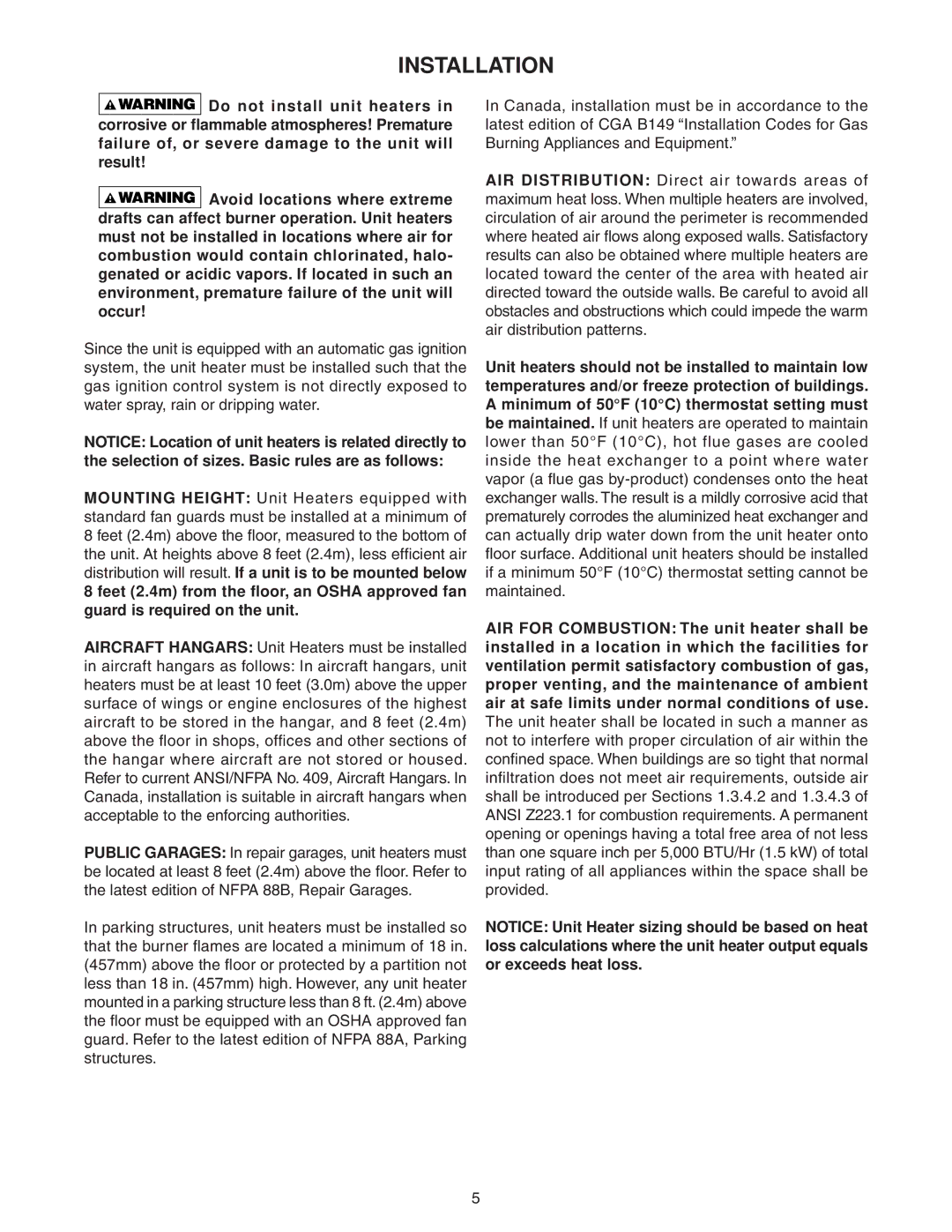
INSTALLATION
![]()
![]()
![]()
![]()
![]()
![]()
![]()
![]()
![]() Do not install unit heaters in corrosive or flammable atmospheres! Premature failure of, or severe damage to the unit will result!
Do not install unit heaters in corrosive or flammable atmospheres! Premature failure of, or severe damage to the unit will result!
![]()
![]()
![]()
![]()
![]()
![]()
![]()
![]()
![]() Avoid locations where extreme drafts can affect burner operation. Unit heaters must not be installed in locations where air for combustion would contain chlorinated, halo- genated or acidic vapors. If located in such an environment, premature failure of the unit will occur!
Avoid locations where extreme drafts can affect burner operation. Unit heaters must not be installed in locations where air for combustion would contain chlorinated, halo- genated or acidic vapors. If located in such an environment, premature failure of the unit will occur!
Since the unit is equipped with an automatic gas ignition system, the unit heater must be installed such that the gas ignition control system is not directly exposed to water spray, rain or dripping water.
NOTICE: Location of unit heaters is related directly to the selection of sizes. Basic rules are as follows:
MOUNTING HEIGHT: Unit Heaters equipped with standard fan guards must be installed at a minimum of 8 feet (2.4m) above the floor, measured to the bottom of the unit. At heights above 8 feet (2.4m), less efficient air distribution will result. If a unit is to be mounted below 8 feet (2.4m) from the floor, an OSHA approved fan guard is required on the unit.
AIRCRAFT HANGARS: Unit Heaters must be installed
in aircraft hangars as follows: In aircraft hangars, unit heaters must be at least 10 feet (3.0m) above the upper surface of wings or engine enclosures of the highest aircraft to be stored in the hangar, and 8 feet (2.4m) above the floor in shops, offices and other sections of the hangar where aircraft are not stored or housed. Refer to current ANSI/NFPA No. 409, Aircraft Hangars. In Canada, installation is suitable in aircraft hangars when acceptable to the enforcing authorities.
PUBLIC GARAGES: In repair garages, unit heaters must be located at least 8 feet (2.4m) above the floor. Refer to the latest edition of NFPA 88B, Repair Garages.
In parking structures, unit heaters must be installed so that the burner flames are located a minimum of 18 in. (457mm) above the floor or protected by a partition not less than 18 in. (457mm) high. However, any unit heater mounted in a parking structure less than 8 ft. (2.4m) above the floor must be equipped with an OSHA approved fan guard. Refer to the latest edition of NFPA 88A, Parking structures.
In Canada, installation must be in accordance to the latest edition of CGA B149 “Installation Codes for Gas Burning Appliances and Equipment.”
AIR DISTRIBUTION: Direct air towards areas of maximum heat loss. When multiple heaters are involved, circulation of air around the perimeter is recommended where heated air flows along exposed walls. Satisfactory results can also be obtained where multiple heaters are located toward the center of the area with heated air directed toward the outside walls. Be careful to avoid all obstacles and obstructions which could impede the warm air distribution patterns.
Unit heaters should not be installed to maintain low temperatures and/or freeze protection of buildings. A minimum of 50°F (10°C) thermostat setting must be maintained. If unit heaters are operated to maintain lower than 50°F (10°C), hot flue gases are cooled inside the heat exchanger to a point where water vapor (a flue gas
AIR FOR COMBUSTION: The unit heater shall be installed in a location in which the facilities for ventilation permit satisfactory combustion of gas, proper venting, and the maintenance of ambient air at safe limits under normal conditions of use. The unit heater shall be located in such a manner as not to interfere with proper circulation of air within the confined space. When buildings are so tight that normal infiltration does not meet air requirements, outside air shall be introduced per Sections 1.3.4.2 and 1.3.4.3 of ANSI Z223.1 for combustion requirements. A permanent opening or openings having a total free area of not less than one square inch per 5,000 BTU/Hr (1.5 kW) of total input rating of all appliances within the space shall be provided.
NOTICE: Unit Heater sizing should be based on heat loss calculations where the unit heater output equals or exceeds heat loss.
5
